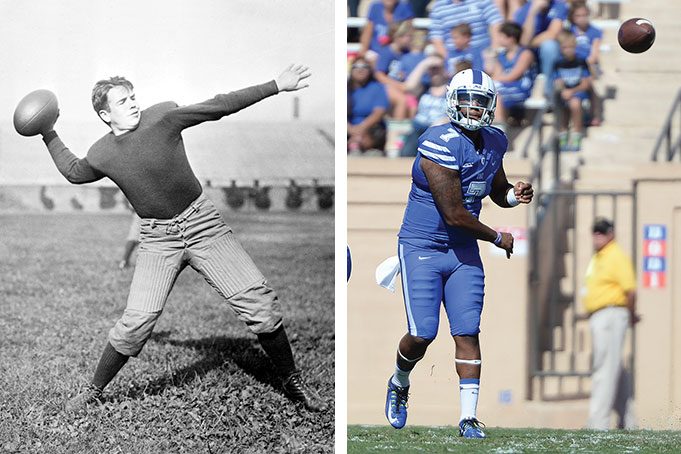Officiating standards and practices have changed considerably over the course of time. So have the rules all of us are expected to know and enforce. The evolution of the rules parallels the evolution of a sport itself. With that thought in mind, here are some of the most significant rule changes in sports history.
Baseball
Baseball is a sport steeped in tradition. In the 19th century, new rules were continually being added and existing ones modified. Since 1903, however, the year of the first World Series, the game has been played pretty much as we know it today.
The most significant alteration to the playing rules since then is the provision allowing for the use of a designated hitter (DH). The DH was officially introduced in the AL in 1973. But the idea of having a hitter bat in the pitcher’s place in the lineup was not a new one; it was first suggested in the early 1900s by Connie Mack, among others.
Today the DH is used throughout professional baseball, with the exception of the NL. A vote in 1980 to adopt the DH in the NL failed. The DH is also a fixture in interleague and World Series games played in AL ballparks and has been in place in the Pacific League in Japan since 1975.
The NCAA and the NFHS each have their own versions of the DH rule. It was incorporated into college baseball for the 1974 season after the Big Ten and Western Athletic conferences experimented with it the year before.
Dick Siebert, the secretary-editor of the NCAA College Baseball Rules Committee at the time, noted, “The designated hitter rule for college will be essentially the same as used in the AL.”
But the college rule also provided that the same player could serve as the pitcher and the designated hitter simultaneously, which has proven to be no small matter in the years since.
In the NFHS rule, added in 1976, the DH is permitted to hit in place of any of the starters, regardless of their position.
Other rule changes may not have been as obvious to the casual fan but have had an impact nonetheless. In the late 1960s, concerns arose that pitching had become too much of a factor in the game. Those concerns increased after a 1968 season that saw just six players in all of MLB hit better than .300. In 1969, the height of the mound was lowered from 15 to 10 inches.
On Aug. 16, 1920, Cleveland shortstop Ray Chapman was struck in the head by a pitch thrown by Yankee pitcher Carl Mays. Chapman died some 12 hours later in a hospital. As a result, the spitball was banned (save for a list of 17 pitchers who had used it to that point and were authorized to continue to use it). Also, umpires were instructed to remove a ball from play once it became discolored.
LINK: Here is a chronological list of baseball rule changes through time.
Soccer
The modern version of soccer dates back to 1863, when the group now known in England simply as the Football Association codified a set of rules that distinguished “association football” from rugby, its first cousin. The latter permitted running with the ball while soccer banned handling the ball, except by goalkeepers.
The Laws that govern soccer have changed relatively little through the years, compared to other sports. But the changes that have occurred have been quite significant.
The penalty kick was introduced in 1891. It marked the first time a goal could be scored directly from a free kick. Previously all other free kicks were indirect. The penalty area as we know it today became a reality in 1902.
The offside Law has also been modified several times. Under the original code, any attacking player positioned ahead of the ball was deemed to be offside. In 1866, the Law was modified to allow an attacking player to be onside as long as there were three defensive players between the attacker and the goal. A 1925 revision required just two defensive players between the attacker and the goal. The most recent version of the Law, which took effect in 1990, allows the attacker to be even with the second-to-last defender without being considered in an offside position.
But perhaps the most significant rule change in the sport’s long history was adopted in 1998, when FIFA decided to crack down on what would politely be termed aggressive defensive play inside the penalty area. A change in the Laws of the Game decreed that a player committing a foul that deprived an opponent of an obvious goal-scoring opportunity be sent off with a red card.
LINK: IFAB – History of the Laws of the Game
Basketball
The introduction of the shot clock is unquestionably the most significant rule change in the sport’s history. It was implemented in the NBA beginning with the 1954-55 season.
The man behind the idea was Danny Biasone, the owner of the Syracuse Nationals. He saw interest in professional basketball, not to mention his gate receipts, decline in the early 1950s. In that era, teams would build a lead and go into a stall.
Biasone reasoned that forcing a team to shoot within a specified period of time would infuse new energy into the sport.
The numbers bore him out. In 1954, NBA teams averaged 79.5 points per game. The following season, with a 24-second clock in place, NBA teams averaged 93.1 points per contest. Within three years, every team in the league was averaging more than 100 points per game.
For most of its existence, the now defunct American Basketball Association (ABA) utilized a 30-second clock before switching to 24 seconds in 1975-76, its final season.
Men’s college teams were experimenting with a shot clock in the early 1970s. A 45-second clock was formally adopted by the NCAA for the 1985-86 season, although the clock was turned off with four minutes left in regulation. A 35-second clock was instituted for the 1993-94 season and continues to this day.
The women’s college game introduced a 30-second clock for the 1970-71 season and has had it ever since. In some parts of the country, high school games utilize a shot clock.
Next to the shot clock, the three-point field goal has had the biggest impact on the sport. It was first used in the American Basketball League in the early 1960s before the ABA adopted it in its first season. The NBA followed suit in 1979-80.
The NCAA adopted a three-point shot for the 1985-86 season and the NFHS added it the following season.
A number of major rules that were fixtures in the early years of the sport were gradually eliminated as the game of basketball evolved to become the game we know today.
Among them:
- Beginning with the 1923-24 season, a player who was fouled had to shoot his own free throws. Prior to that, one player per team would usually handle the assignment.
- Until the 1937-38 season, there was a center jump after each basket.
- Goaltending wasn’t banned until the 1944-45 campaign.
- The free-throw lane was widened in all levels from six to 12 feet in 1956. The NBA eventually widened it to 16 feet.
- In 1972-73, free throws were eliminated for the first six common fouls of each half. In the NBA, the three-to-make-two and two-tomake- one bonus free throw rule was eliminated in 1981. Now on the fifth team foul committed in a quarter, or if a team commits more than one foul in the last two minutes of a quarter, the opposition gets to shoot two free throws.
- In 1981-82, the alternating possession arrow replaced the jump ball save for the start of the game and each overtime period. The jump ball is still used to settle situations after a held ball during NBA games.
Football
Today, the forward pass is a common strategy. That wasn’t always the case. The forward pass wasn’t legalized until 1906 amid a plethora of restrictions.
Only one forward pass was allowed in any one series of downs. Moreover, a pass that was touched by a player but not caught became a free ball. And if a forward pass hit the ground without being touched, the ball was awarded to the defensive team.
The passer had to be five yards to the left or right of the center. A rule change in 1910 allowed one forward pass on any down but the passer had to be five yards behind the line of scrimmage. That was part of the reason the field was lined in a gridiron pattern for the six-year period from 1904-09.
The forward pass is what distinguishes football from its forebears but there have been a host of other significant rule changes over the course of time.
For the first decade or so of its existence, the NFL played under collegiate rules. That changed in 1933 when the league made several modifications unique to the professional game. Chief among them were making the forward pass legal from any point behind the line of scrimmage as opposed to five yards behind it (the NCAA adopted the same rule in 1941), and moving the goalposts from the end line to the goalline (they were moved back to the endline in 1974).
From then on the NCAA and the NFL traveled separate paths as far as the rules were concerned.
In the post-World War II era, there were major changes to the substitution rules. In 1941, the NCAA allowed unlimited substitutions for the first time, only to abolish “twoplatoon” football eight years later. The substitution rules were liberalized, albeit gradually, in the 1960s. The NFL adopted a free-substitution rule on a permanent basis in 1950.
In 1978, the league liberalized the rules for offensive linemen engaged in pass blocking, allowing contact with open hands. The NCAA adopted a similar rule two years later before revising it in 1985 and the NFHS in 1988.
It wasn’t until 1969 that the NFHS allowed a two-point conversion after a touchdown.
LINK: An NFL feature on rules evolution.
Hockey
The NHL was born in 1917, but ice hockey dates back to at least the 1850s. The earliest set of rules, which originated in Halifax, Nova Scotia, were superseded some two decades later by what were called the Montreal or McGill (University) rules.
Originally there were seven players to a side (the six-player game was introduced during the 1911-12 season) and there were no lines on the ice. Two blue lines were added for the 1918-19 season and the rules concerning the lines have been periodically adjusted since then.
At first, forward passing was prohibited inside the blue line, meaning a player had to carry the puck into the 40-foot wide neutral zone, the only portion of the ice where forward passing was permitted. Starting in 1921-22, goaltenders could pass the puck forward in the defensive zone, but only up to the blue line.
Forward passes within the attacking zone were forbidden until 1929-30. A version of the offside rule was introduced that same year and a forerunner of today’s icing rule was adopted for 1937-38.
It wasn’t until 1943-44 that the puck could be passed from behind the blue line into center ice. A red line was put in that year to divide the ice surface in half and to mark how far that pass could travel. Introduction of the red line marked the start of the game’s modern era. In 2005-06, the red line was removed for the purposes of offside (although not for icing). The change allows a pass to be made from inside the defensive zone all the way to the opposite blue line.
The rules concerning penalties have also been periodically altered through the years. The most significant change came at the start of the 1956-57 season, when a player serving a minor penalty was permitted to return to the ice when the opposition scored a goal. Prior to that year, the penalized player served the full two-minute penalty regardless of circumstances. It was not uncommon for a team with a proficient power play to score several times during that span.
The rules governing equipment have been altered as well. In 1967- 68, the league addressed the issue of curved sticks, limiting the curve of the blade to an inch and a half. Two years later, the limit was reduced to one inch. In 2013, the maximum size for goaltender’s pads was reduced.
LINK: Here is a detailed list of Hockey rule changes.
Volleyball
Volleyball dates back to 1895, but it was some time before today’s game evolved from there, in part because various organizations published their own versions of the rules.
At first there was no limit to the number of players permitted on each team. In the years after World War I, six players per team became the standard and a team was limited to three touches of the ball on its side of the net, thus establishing the basic foundation of the game we know today.
Over the next nine decades, changes to the rules were, for the most part, intended to allow more freedom for the players, both in terms of their movement around the court and how they were allowed to play the ball.
Historically, rule changes originate with the International Volleyball Federation (FIVB) and spread from there to other levels of play.
In 1997, the concept of the libero was introduced. The libero is a specialized defensive player. The libero was formally incorporated into the FIVB rulebook in 1998 and spread to other codes from there. While its use is not mandatory, it is common at all levels of the sport.
The scoring system has evolved as well. For many years, volleyball utilized side-out scoring. Matches were best two of three games with games played to 15 points; a twopoint margin was required for victory. Only the serving team could score; the receiving team would gain possession if it won a rally, but that was all.
In 1999, FIVB introduced rally scoring, which allowed either side to score a point whether it was serving or not. Sets are customarily played to 25 or 30 points, depending on the governing body, and most matches are now decided on a best-of-five basis.
LINK: A summary of 95 years of rules from USA Volleyball.
Softball
Softball purists will contend that their favorite game isn’t a variation of baseball. Despite the differences in the two sports, there are some similarities when it comes to the evolution of the rules, which is logical since softball was originally designed as an indoor version of baseball.
Apart from the size of the field and the requirement that pitchers use an underhand delivery, softball’s most distinguishing characteristic is that runners are confined to their bases until the pitch is released (fast pitch) or crosses the plate (slow pitch).
Softball icon Emily Alexander recalls a time when the pitching circle we know today was not actually drawn on the ground and runners could play cat and mouse with pitchers before finally returning to the bag. The “look-back rule” came into being sometime in the late 1970s but wasn’t called that in the rulebook until the early to mid-1990s.
But perhaps the most significant rule change in the sport’s history was the implementation of the DP/ FLEX rule. It was first introduced into ASA play in 1988 when it was called the DP/DEFO (defense only) rule. The rule allowed an extra player to be actively involved in the game, highlighting softball’s emphasis on participation.
Through the years, the sport has modified its rules and equipment to suit the changing times. In the early 1970s, the metal bat was introduced. By the early 1990s, in an effort to add more offense to the game, the NCAA introduced an optic yellow softball. The ASA authorized the use of the yellow ball in 1998.
What's Your Call? Leave a Comment:
Note: This article is archival in nature. Rules, interpretations, mechanics, philosophies and other information may or may not be correct for the current year.
This article is the copyright of ©Referee Enterprises, Inc., and may not be republished in whole or in part online, in print or in any capacity without expressed written permission from Referee. The article is made available for educational use by individuals.



















